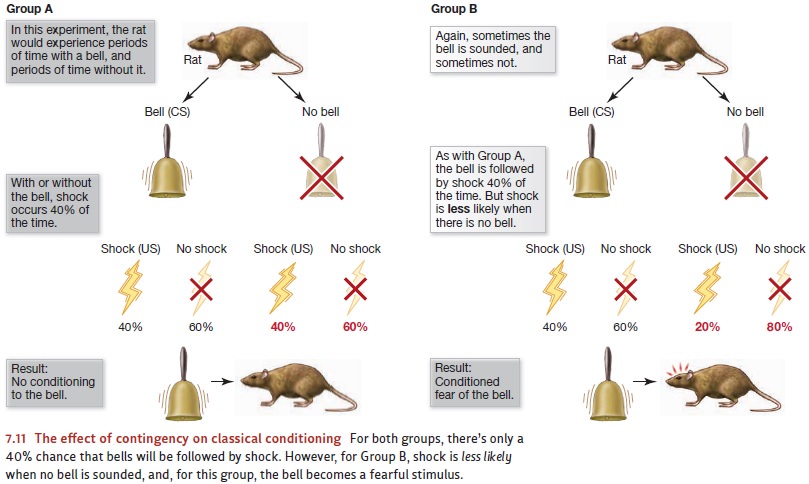Chapter: Psychology: Learning
Classical Conditioning: Contingency

CONTINGENCY
TheCS’s role as a signal also has
a crucial implication for what produces
classical conditioning—that is, what the relationship between the CS and the US
must be for learning to occur. To understand the issue, consider a dog in a
conditioning experi-ment. Several times, it has heard a metronome and, a moment
later, received some food powder. But many other stimuli were also present. At
the same time it heard the metronome, the dog heard some doors slamming and
some voices in the background. It saw the laboratory walls and the light
fixtures hanging from the ceiling. At that moment, it could also feel various
bodily sensations. What, therefore, should the dog learn? If it relies on mere
contiguity, it will learn to associate the food powder with all of these
stimuli—metronomes, light fixtures, and everything else on the scene—since they
were all present when the US was introduced.
Notice, though, that many of
these stimuli—even if contiguous with the US—give no information about the US.
The light fixtures, for example, were on the scene just before the food powder
arrived; but they were also on the scene during the many min-utes when no food
was on its way. So the sight of the light fixtures can’t signal that food is
coming soon, because the presence of the light fixtures has just as often
conveyed the opposite message. Likewise for most of the sounds in the laboratory;
they were present just before the food arrived, but they were also present
during minutes without food. Therefore, none of these stimuli will help the
animal predict when food is coming and when it’s not.
To predict the US’s arrival, the
dog needs some event that reliably occurs when food is about to appear and
doesn’t occur otherwise. And, of course, the metronome beat in our example is
the only stimulus that satisfies this requirement, since it never beats in the
intervals between trials when food is not presented. Therefore, if the animal
hears the metronome, it’s a safe bet that food is on its way. If the animal
cares about signal-ing, it should learn about the metronome and not about these
other stimuli, even though they were all contiguous with the target event.
Are animals sensitive to these
patterns? Said differently, what is it that leads to clas-sical conditioning?
Is it contiguity—the fact that the CS
and US arrive close to each other in time? Or is it contingency—the fact that the CS provides information about the
US’s arrival? It turns out that contingency is the key, and in fact a CR is
acquired only when the CS is informative about things to come.

In one experiment, rats were
exposed to various combinations of a bell (CS) and a shock (US) (Figure 7.11).
The bell was never a perfect predictor of the shock, but it did signal that
shock was likely to arrive soon. Specifically, presentation of the bell
signaled a 40% chance that a shock was about to arrive.
For some of the rats in this
experiment (Group A in the figure), shocks also arrived 40% of the time without
any warning. For these rats, therefore, the bell pro-vided no information. The
likelihood of a shock following the bell was exactly the same as the likelihood
of shock in general. And in fact this situation led to no condi-tioning;
instead, the rats simply learned to ignore the tone.
For another group of rats (Group
B in the figure), the bell still signaled a 40% chance of shock, and shocks
still arrived occasionally without warning. For these ani-mals, though, the
likelihood of a shock was only 20% when there was no bell. So in this setting,
the bell was an imperfect predictor but it did provide some information,
because shock was more likely after the bell than otherwise. And, in this
situation, the rats did develop a conditioned response—they became fearful
whenever the bell was sounded.
Let’s be clear that in this
experiment, the two groups of rats experienced the same number of bell-shock
pairings, and so the degree of contiguity between bell and shock was the same
for both groups. What differed between the groups, though, was whether the bell
was informative or not—and it’s this information value, not the contiguity,
that matters for conditioning. Notice also that the bell was never a perfect
predictor of shock: Bells were not
followed by shock 60% of the time. Even so, conditioning was observed;
apparently, an imperfect predictor is better than no predictor at all
(Rescorla, 1967, 1988; Figure 7.12).

Related Topics